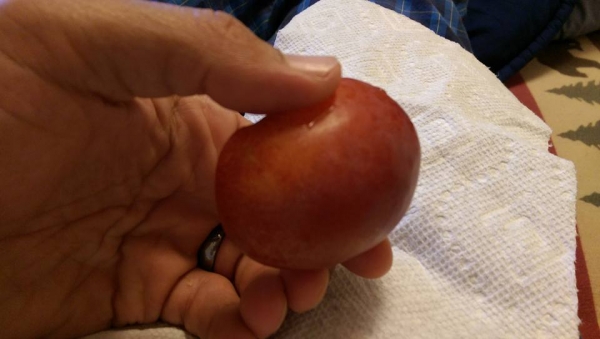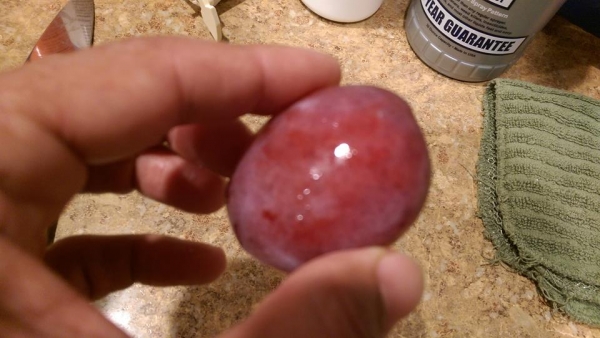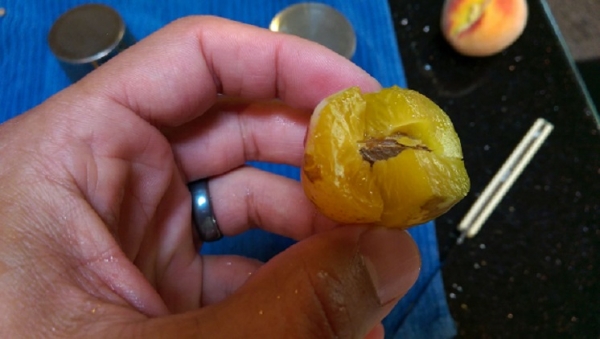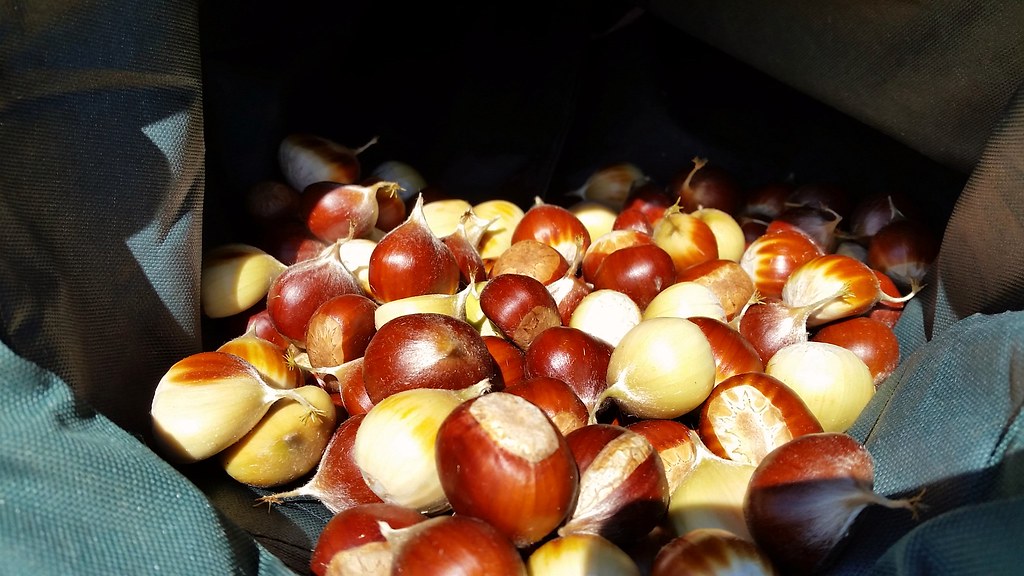Its always fun for me to see what others are growing and harvesting, especially in the area. Successes, no matter how small can be inspiring.
Please share photos of what you're harvesting.
Most of what I get this time of year never makes it into the house, its just enough for browse for daughter and me. Every once in a while a handful of something will make it in for my wife who doesn't share our love of hand-to-mouth harvest.
But here is about 50% of my haskap harvest this year, which I made into sauce by boiling with some vanilla sugar. (My daughter thinks currants, aronia and haskap are as normal as raspberries and blueberries).
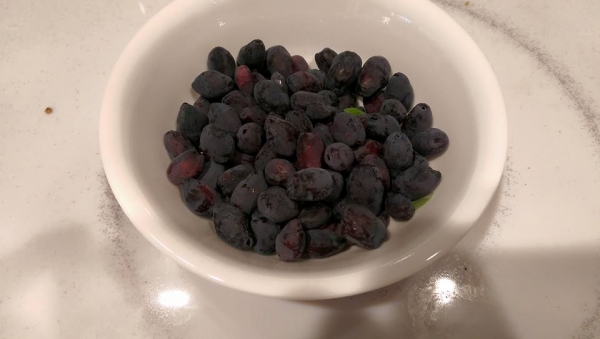
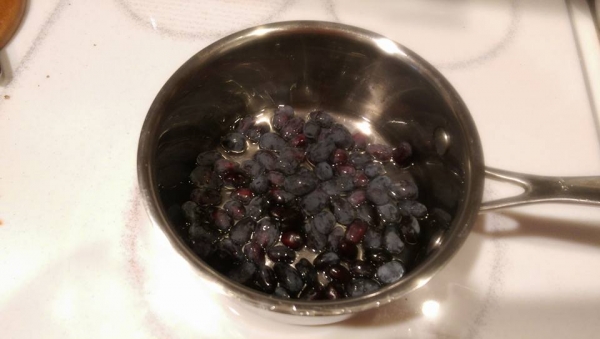
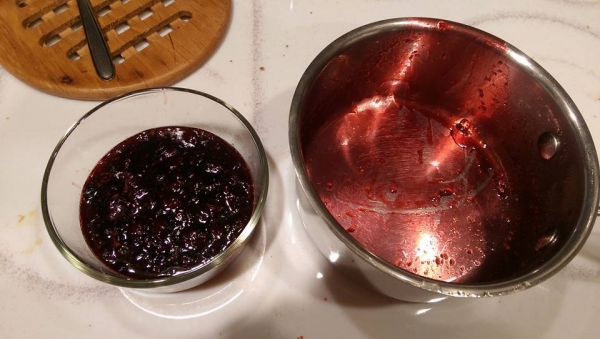
I'm also harvesting a lot of honeyberries/haskap and pie cherries. Strawberries were good but mostly done now. Blueberries are turning too. I need to go out and check the currants. I can see that the mulberries are turning color but they're not ready yet.
John S
PDX OR
How could I forget? We've been gathering lots of raspberries every day. I sometimes forget because it's my wife's, and there are so many berries that it feels like work sometimes, rather than an exciting discovery. Just had my first hidden fat blueberries and mulberries. My black caps are just about ready to fall off. They are called black raspberries in other parts of the country where they aren't native. They are the # 1 medicine to fight oral cancer, one of our top ten cancer killers, even in hospitals, they smear the berry on the lesion. We can just eat the berries. By the way, they taste good too.
John S
PDX OR
Those honeyberries look good! I ate a couple. My neighborhood deer find the entire plants delicious, too.
I've been browsing mulberries. I finished off the cherries from Montmorency last week. I eat them off the tree. A little sour but I like them. There might be a few figs next week. Lattarula and King usually compete for the first brebas of the summer.
I don't know if they count as orchard fruit, but we ate our first Sungold tomatoes last week.
Summer can be very delicious.
(My first post here 🙂
Daniel W.
Welcome Daniel.
Tomatoes this early is impressive. They must have gotten quite the head start in the greenhouse.
Cherry harvest was a bust for me this year. Most of the fruit was damaged. I only got a few handfuls of very sweet but under ripe red ones. They all got holes in them before they got purple. My daughter enjoyed the ones she had anyway.
Good news is several of the new variety grafts took. I'm hoping the pest pressure is reduced, or at least varies with future weather.
Welcome Daniel,
I also grow honey berries., mulberries, pie cherries and figs. Although Congress declared the tomato a vegetable (didn't they have any actual work to do?), it is botanically a fruit. I'm still hoping, but I've got a long ways to go to eat them.
John S
PDX OR
I've been picking a bowl like this every day for the last 3 days:

This bowl is about 12" diameter.
The raspberries are starting to wane but the marionberries are starting to flourish.
It seems like the raspberries that get a little shade are happier than the ones in full sun next to a fence. Where do your best raspberries grow?
Thank You Jafar and John for the welcome!
Possibly next on my harvest is El Dorado peach grown in container. I dont know how big they get, but it feels like they are close. It is on a deck in full sun.
Yes, the tomatoes got a head start in greenhouse. I wondered if we started them too early but, so far, so good.
I am very anxious to start eating plums. That might be a month or so away.
Jafar, I think an unknown in my little orchard is about ripe. Birds ate two already.
I've thought about adding Beauty to my multigraft. I don't know Early Laxton. Google says it's an early European. You like it?
These are the first ever peaches from my containerized El Dorado peach tree.
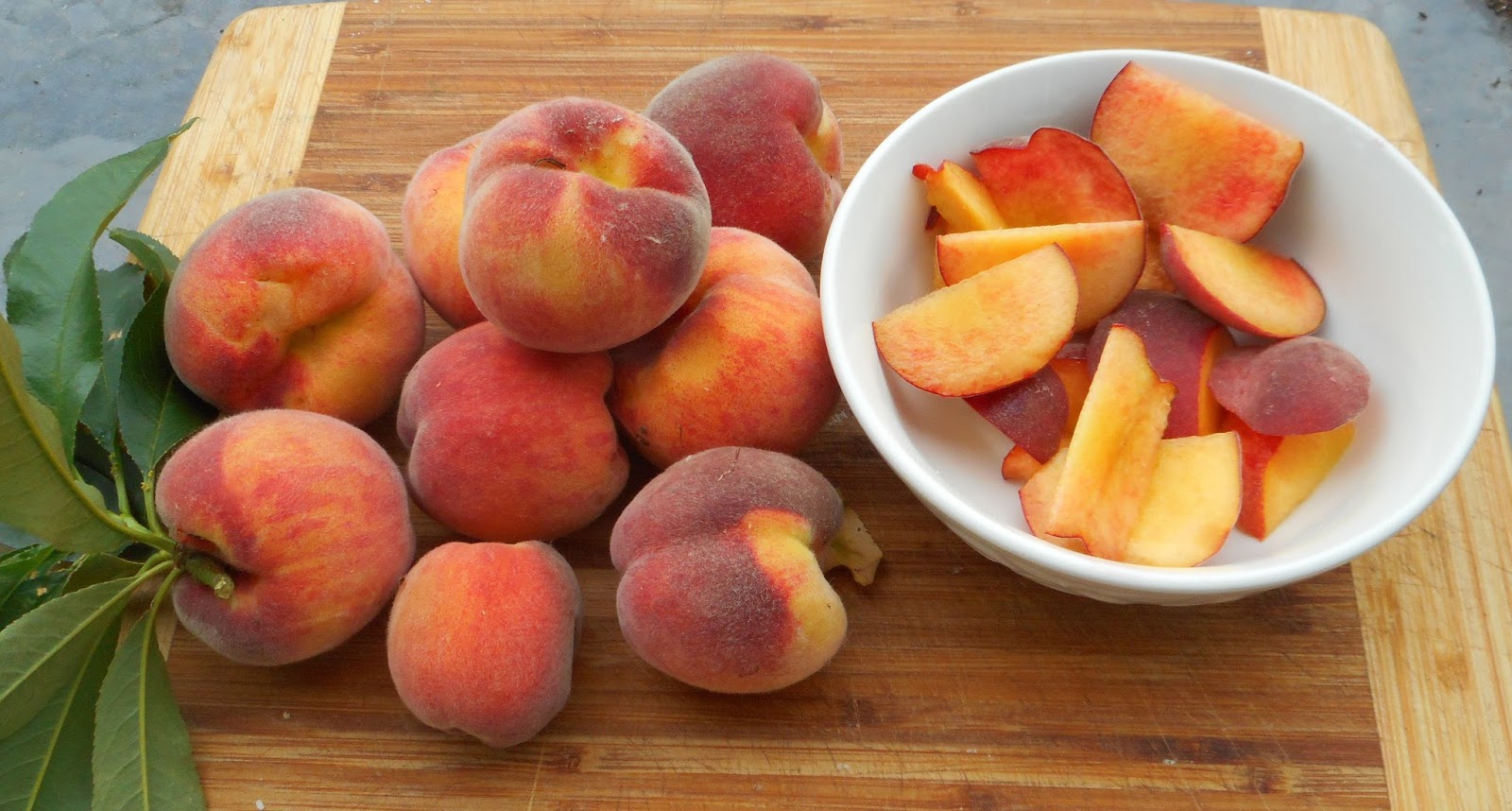
I'm not the world expert on peach flavor. These have a bit of tartness. The flesh is firm and juicy. They have a peachy flavor. Compared to grocery store peaches, I think they are wonderful.
Daniel,
Those look gorgeous. I just saw them on your blog before coming here. I was wondering what curl resistant cultivar made such lovely and early peaches. But I see it is a genetic dward in a container, so probably not curl resistant but rather sheltered for the winter.
I do like Early Laxton, better than most Japanese plums. My mom doesn't like it and prefers Beauty. I won't eat Beauty raw.
But it cooks great given obscene amounts of sugar: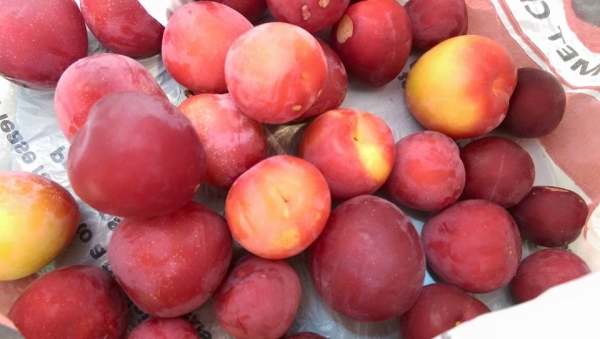
I crushed them in my hands and pinched out the pits:
Broke up the skins with an immersion blender (optional):

After simmering for 15 minutes or so i added an obscene amount of sugar, then went upstairs and monitored it on security cam remotely so I didn't have to stand over it while it cooked down.
The resulting sauce/jam is a very deep red color. It seems redder than can be accounted for by the skins (flesh is orange). I wonder if these have pro-anthocyanins like quince that are brought out with heat and time.
Jafar,
That plum sauce looks like a great idea. Last year we made freezer jam using Hollywood and Shiro. They were delicious, and good on pancakes or yogurt during the winter and spring.
Here are a few Mystery plums. I rescued the tree from deer in 2012. These are the first plums.

My Methley had its first plum, ever, today. I was similar to the mystery plum, but maybe bluer outside, redder inside, sweeter, and more juicy. Can't really say based on one plum, and the riper mystery plums were more like Methley, compared to the less ripe ones.

Sorry about image size. I haven't got the art of posting images down as well as I would like.
Shiro Plums. The first today. I think they'll be ripening fast over the next few days.

Figs. King and Lattarula. The brebas look about the same, and I don't think there is a big difference in taste. Big, juicy, sweet figs. Not as "figgy" or crunchy as dark figs, but they are ripening and delicious.
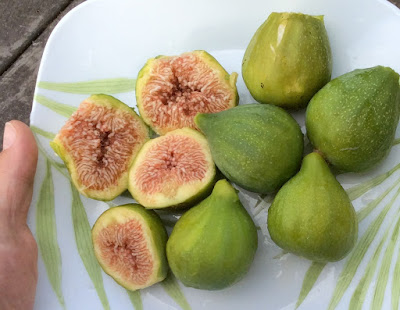
We are coming into prime fruit harvesting in my little orchard. Plums, figs, and there should be some more peaches soon.
Lovely peaches, Daniel.
I am harvesting Q1-8 peaches (peach leaf curl resistance variety) though I will probably have to (reluctantly) cut the tree down this year due to bacterial canker. It has become very top-heavy because that is where the good growth is located. If I didn't have it held up by stakes and twine, it would have fallen over. I almost cut it down last year but I'm glad I didn't b/c I have my best yield this year.) The peaches are very delicate and bruise very easily.
I lost one other peach tree due to PLC. I have read that Charlotte is somewhat resistant to bacterial canker but peach leaf curl would still be a problem. I am tempted to try growing that variety in a container and keeping it under the polycarbonate patio roof to prevent PLC.
(Note: I wanted to post a photo but I don't seem to have a "browse" selection button...only "View Existing Image Uploads" which appeared when I tried to post images for another post but was told they were too large even though they were re-sized.)
redberry
Start a post/reply. Scroll down below the text entry window and click "Upload Attachments".
Then either click the "add files" button and browse your computer to find the image file, or drag and drop your file into the indicated area.
Then click "start upload' once your file(s) are queued.
The difficult part is that your file size has to be 100 Kilobytes or less which isn't a very big file size. Editing your picture file to save it a little smaller isn't very hard, but does take some extra steps.
I'm hoping our Admin can help make this a little more user friendly.
I also had trouble loading pictures earlier so I'll see if the instructions work. What is odd is that it seemed like it was obvious earlier....anyway......some of my Q1-8 peaches. They are averaging about 4-6 oz. Some have damage from stink bugs earlier in the season. I use footies to protect them. Since I tie them to the branch, they also serve to save them from falling onto the ground if I don't pick them in time.
redberry

Jafar, are your Shiro ripe now? Maybe with the cooler situation, they don't ripen all at once. Or maybe they do.
King Figs. I made some jam but ate and gave away most, fresh.
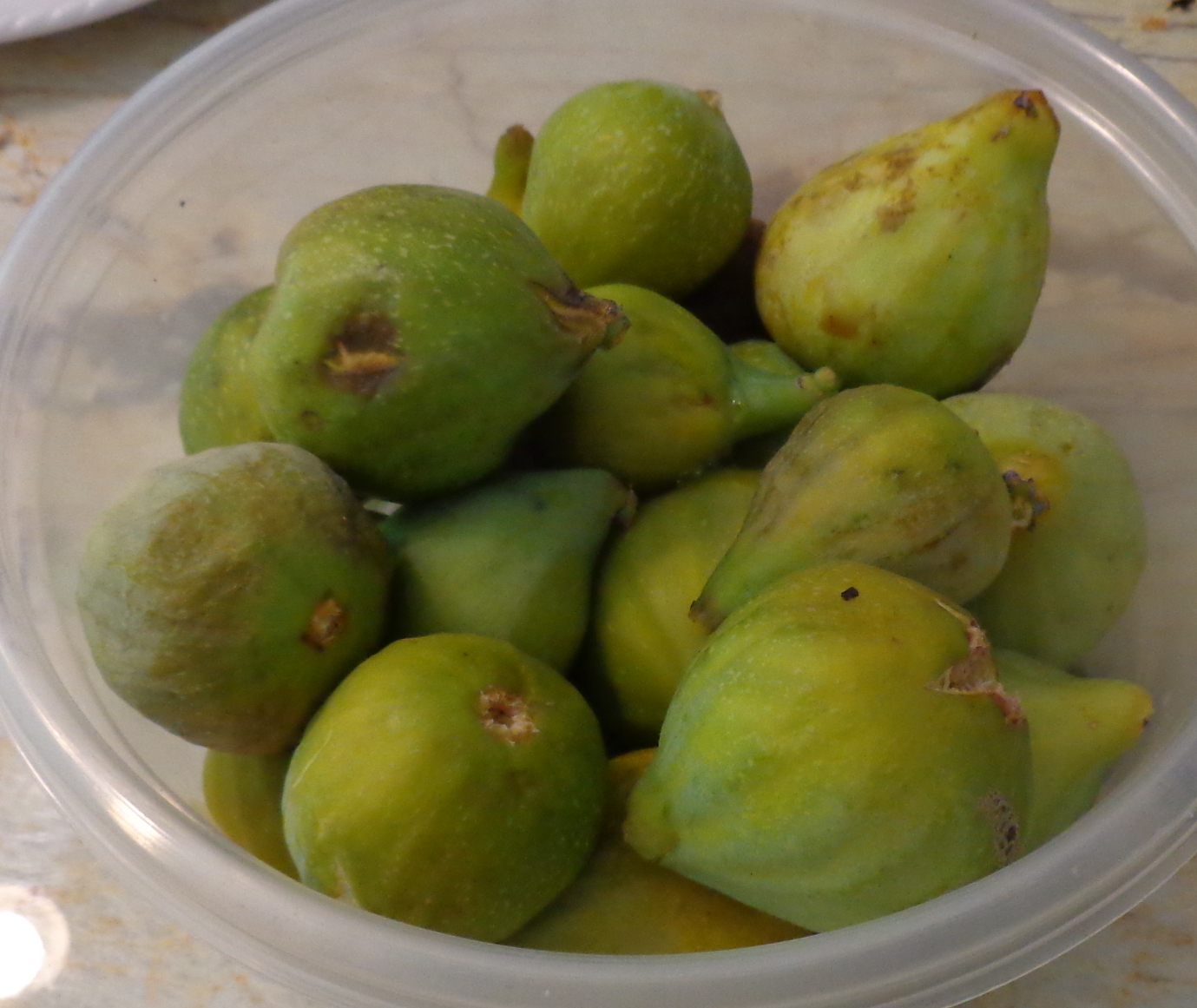
Petite negri figs. On the fig forum, these were thought to be Aubique petite, or Negronne, or something else. I bought the tree as a little stick with roots, via male order from a S. Carolina nursery in 2001. Very slow growing. I've grown offspring from dormant cuttings and they are also slow starters. Once it's in the 6 foot tall range, it's pretty productive, especially the fall crop.
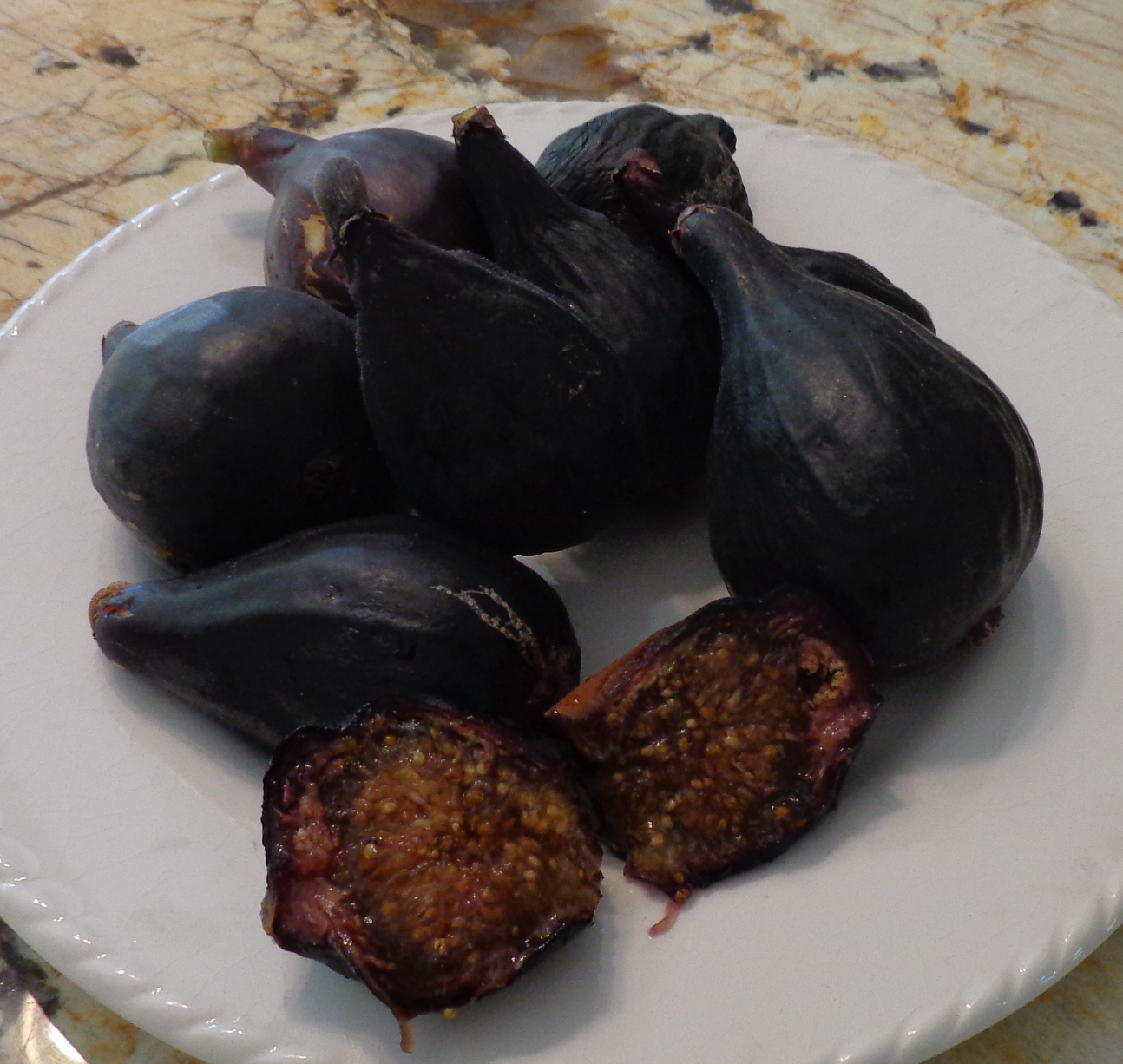
Most years these figs are more scarlet inside. Either I let them go a little too long, or the heat resulted in a more brown color. Still very "fig" flavor and sweet and juicy.
These are my first apples ever at my Battleground place. They are on a triple-graft from Raintree, planted bare root Jan or Feb 2014. This branch is Pristine. The other varieties are not ripe, they are Rubinette and Queen Cox. It looks like there will be a taste of those, this fall. The stained apple is a result of my bagging them in zipper bags. That turned out to be not necessary and caused discoloration for some fruits.
Pristine turned out to be kind of spritely, juicy, and crisp. Not over-sweet. The pink blush on the yellow apple is attractive. They had no disease, which is what I would expect from a PRI apple at first taste. I like this apple. Really early.
These are also my first peaches ever at my Battleground place. They are Oregon Curl Free. I have not been watering the tree except in extreme heat. That may be why they are small. I don 't mind small size. The seeds are also small, so there is relatively more flesh than expected. The flavor is wonderful - full "peachy" flavor, also quite spritely, juicy, with a touch of astringency in the skin. I like that touch on peaches, along with the fur, but I know not everyone does.
The plums are Hollywood. Very productive this year. Needed more thinning than I was up to. Many will go into jam. I gave away a lot at work. People like them. Dark red inside and out.
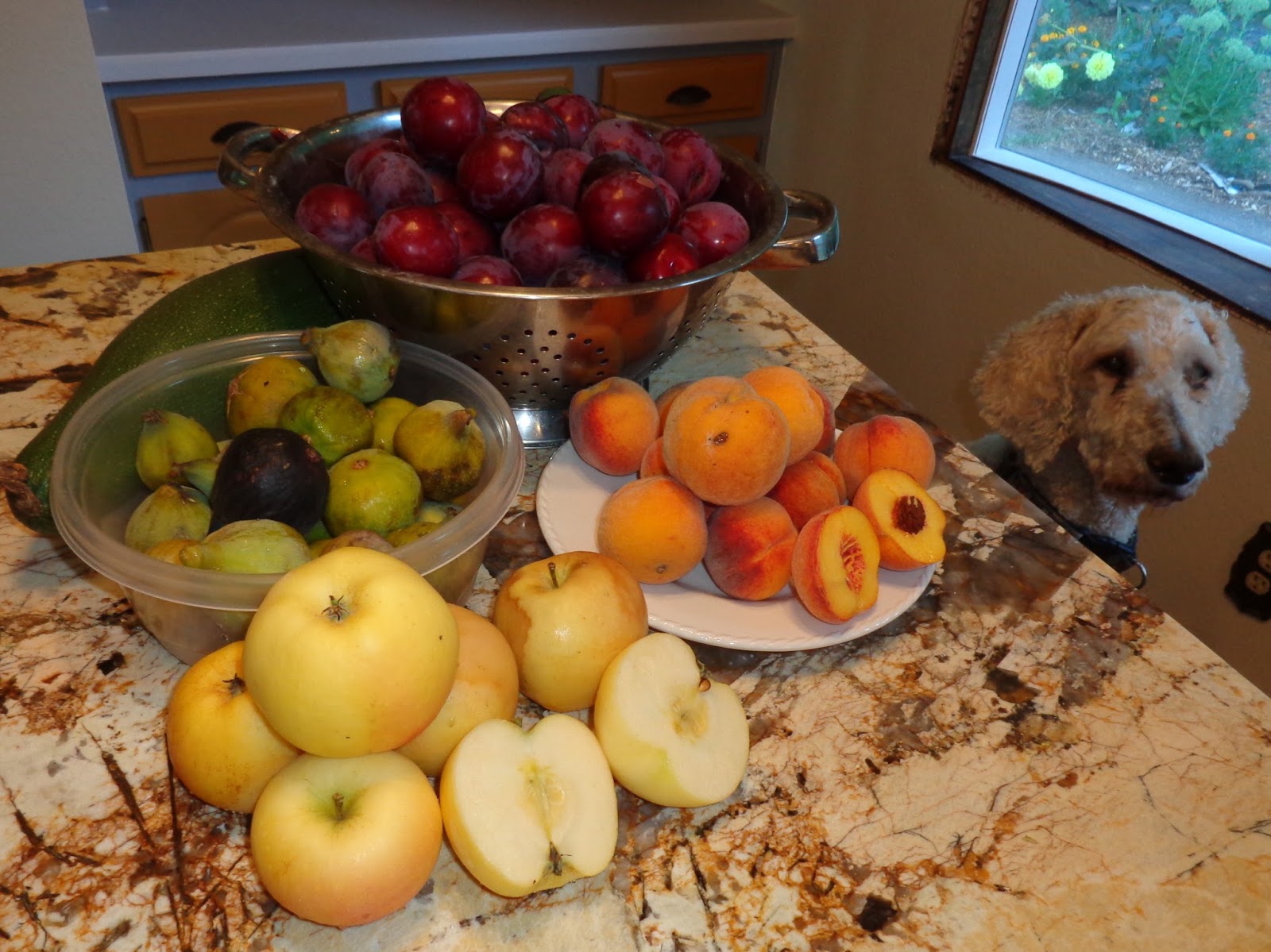
There have been a few remaining mulberries. The tree took off this year with a big increase in size, so next year is promising.
I hope others are having a great fruit season!
Jafar, that's a nice looking plum!
I looked for info on Yakima - there is a brief description on the Grandpa's Orchard website. It must come from Yakima!
Yes, but strangely they cannot be found in Yakima anymore. There was one orchard that had them until a few years ago. It was a pain to find the scions. You are welcome to bud wood or dormant scions if you like.
This fruit was from a peach tree that wasn't doing well so I grafted over to various Euro plums.
I have another tree that is on St Julien that is on its 5th summer and quite big that hasn't fruited yet (can't remember if it bloomed this spring).
Jafar, if you are still up for that this late winter/early spring, I would like to take you up on the scion offer. I am always wanting to see how different varieties do here, especially ones that have a potential for good local growth and production. Of course, I am always open to sharing my varieties as well, plums or otherwise.
Jafar,
How many different plum varieties do you have? I have several different plum rootstocks needing summer budwood grafts but it's hard to find sources. For the most part, I've had pretty good success with T-bud grafts in the summer in recent times; it gives me a chance to re-use rootstocks that failed from dormant wood grafts. (In the past these have been easy for me, but our recent local "heatwaves" have put a lot of stress on dormant-grafted plants during the spring and summer in the last couple of years. Climate change. Our weather is thoroughly wacked-out here.)
If you're willing, let me know which plum varieties you have and I'll gladly pay for the budwood and the shipping.
Tim.
P.S. -- I'd hoped to get to the HOS Arboretum event yesterday (Saturday), but realized Friday night that I had too many things to get done this weekend. How was it? I'll meet you guys yet. It's a pity that I've been a member of the HOS for several years but have yet to get to an event other than the "All About Fruit Show" and the big spring "Scion-wood Giveaway"! Those alone are worth the membership price, but it would be nice to get to know some of the HOS fruit enthusiasts personally. Mostly it's been the driving distance to events that puts a crimp on getting down that way.
Tim, I have a number of varieties of plums, but some on trees that aren't very healthy. I think much of the problem may be thrip damage
I have Yakima and Jefferson on individual trees that look good. I prefer dealing with dormant scions if mailing is involved. You're welcome to come visit and collect some bud wood.
I also have Shiro and Howard Miracle with plenty of new growth.
Isn't this a wonderful time of year?! There is always something from the orchard and garden . Now it's grapes. I have an arbor over a small deck, which leads to my bedroom. The theory was, the grapes would shade the patio door in the summer, keeping the room cooler. With dormancy, they would let the sun in during the winter. The exposure is South facing.
In reality, racoons and possums get into the grapes at night, usually midnight or 1am. That gets my dogs excited, they wake me up, I let them out, they chase off the varmint, come inside, I go to sleep, then it repeats in an hour.
But, the grapes are worth it. These are Price (blue), Interlaken (green), and Venus (blue). Venus isn't bad at all, but I love the other two more. They are like candy. I also have Canadice, which I don't care as much for. It just seems sweet but not very grapey.
There were some questions about grafted grapes. These are cutting-grown, on their own roots. The vines are 13 or 14 years old, very vigorous.
Daniel. Venus is one of the many grape varieties I grow. It bears well, but I also rate the fruit at the bottom of my list for flavor/texture combo. But I have a coworker who just loves them and thinks they are the greatest ever. To me they are like a watered down Concord or something, not very flavorful.
I've never tried Price.
Jafar, as I remember, I got Price because Lon Rombaugh rated it highly in his book. It has seeds, slipskin, and they are reasonable size grapes. I like them very much. The bunches are small but I dont mind that.
I want to move the vine to my Battleground place but it might be better to just take cuttings. I have Buffalo, Einset, and Lynden there but didnt give them much attention and they are still small. I also want to move the Interlaken but again it might be smarter to just take cuttings and really nurture them for a couple of years.
Just eating peaches from our seedling tree. Probably originally Elberta. Bumper crop and tastes great.
Still eating tons of black mulberries:very long harvest season.
Amazing amounts of thornless blackberries.
Himalayan Honeysuckle:productive and flavorful. Problem free and beautiful.
Lots of apples: Dolgo, McIntosh, Akane, Cox's Orange Pippin
John S
PDX OR
Jafar, this question might be better for another thread - I don't want to derail. But I will ask here and see what you think. I have never measured brix. I just taste and see if I like it. I assume brix just tells you sweetness? Or is is an indication of the sum of all flavor compounds in a food? Would a fruit with high acid + high sugar have the same brix as the same amount of sugar without the acid?
Starting to get some Toka plums. Had the first Charlotte peach. Not ripe enough. Stanley plums are still rock-hard.
Boy, folks... just skimming through all these pictures makes me hungry! Fruit diversity!
My wife and I went "up" to Raintree Nursery this past Saturday for the orchard tour. There was a nice small group there and owner Sam Benowitz took us around for fruit tasting and answered questions.
'Desert King' figs were in prime condition so we ate quite a few. I'd forgotten how good figs can be! It was also a chance for me to sample 'Dolgo' crabapples. They were surprisingly good with a nice nuance that I couldn't quite describe. I'm gonna have to grow one now. It's the kind of flavor that would go well eaten fresh, or used in jellies, preserves, or soft and hard ciders. Also sampled a few other apples, sea buckthorn, cornelian cherries, etc. Unfortunately Japanese plums were just past and European plums not yet ripening. Sam said that with the mild spring and hot weather that we've been getting everything was about 3 weeks earlier than normal.
Here at home I'm eating the last of the blueberries and black currants, but the "wild" cut-leaf and Himalaya blackberries are coming into production. 'Buffalo' grapes (an earlier ripening Concord-type) are just starting to ripen. The plums on the 'Marianna 2624' are now past but I'm amazed at how many were produced this year.
Keep the photos coming. Better than a food magazine!
Tim.
As an aside, the Dolgo crabapple was developed by Niels Ebbesen Hansen in 1917. Hansen wanted to develop fruit trees and other plants that were suited to his adopted Northern Midwest, and were productive and delicious. In that sense, Hansen was the "Luther Burbank of North Dakota", or for modern readers, the Zaiger of his time. Except he worked for the USDA. His contributions were and are amazing. I think some should be tested and possibly brought back, as being more suitable for non-California climates - especially Northern - compared to the Zaiger/Dave Wilson varieties which often appear to be California adapted.
Hansen, agricultural explorer.
Probably a topic better suited for another post. I saw "Dolgo" and thought, a hah!
Tim, it's been years since I went to Raintree. Might be worth a fall drive. Thanks for the post. I agree with things being about 3 weeks earlier. On the positive side, I have several figs that often disappoint in the late fall rain, turning to moldy mush. This year is their chance!
Jafar, thanks for the brix info. Another thing I should learn.
Toka plums
Now fully ripe. They tend to fall off the tree with the smallest movement. I lost some to birds.
They are so worth it. Incredibly sweet. Apricot flavor. Like apricots drenched in honey.
Might be too juicy for some - fully ripe they have a texture like Shiro. Semi-freestone. Some pits almost fall off, and others are tenacious.
Developed by N.E. Hansen in 1911. Self fertile, tend to overbear and need thinning.
So worth it.
Daniel -- Thanks for the couple of links on Hansen. I knew about some of his important hybridizing work but wasn't aware of the breadth of his interests and contributions. In southern California we had 3 'Hansen's Bush Cherries' just outside the back door which produced amazingly well despite the oppressive summer heat of the Pomona Valley.
How do his Japanese-American plum hybrids do in southwest Washington? I'd like to grow more stonefruits, but our local area seems to have a lot of disease problems such as brown rot, shot-hole fungus, etc.
Tim.
Jafar, the name "bubblegum plum" made me hesitant to try Toka, but I bought it due to pollination and bearing descriptions. I dont think it tastes like bubblegum. They do have a very fruity flavor. Maybe "juicyfruit"? The apricot and plum both come through very well. Pluot-like but different pluot.
Tim, Ive only just begun to test Hansen plum varieties. Most seem almost lost through time. Fedco in Maine offers some. So far Toka is doing well and graft of Hanska is very vigorous. I hope it bears next year.
John those are beautiful berries! And tasty! I go through backwards method to post pics, first post to my personal blog on blogspot. Then this site lets me post via the web address. I am yet to be able to post directly from computer or tablet. Im not very web proficient.
Yeah, John and Daniel. The picture uploading to this site would be fairly straightforward if not for the overly restrictive file size. It's something I'm working on. I think it is constrained to limit the resources required to host them.
In Daniel's case, he's hosting them on another site, so this site needs only to point to them. If for some reason the site where they are hosted has a problem, the pictures won't be visible here. That's the sort of thing you run into when you read forums from 5 years ago and all of the pictures are gone. It's because the original Photobucket account (or wherever the pictures were hosted) is gone and those pictures no longer available at that location.
Presumably pictures that are directly uploaded here will be available as long as this forum is. But right now they are limited to 100KB each. (John, your pictures are 42 and 37 KB respectively, so they could be twice as big which is still small.
Daniel, I'd love to taste Toka sometime, although it sounds like I may be late this year. They look and sound wonderful except for the part about having a texture similar to Shiro.
Jafar, you are right about being late for a taste of Toka this year. Most were very ripe when I posted. I will look at the tree this weekend and if there are any left, let you know. Kind of a drive for you to taste a plum but they are not common.
I'm almost "plummed out" now. This was a good year. Stanley might be ripe, they are fully blue now.
Thanks Daniel. I'm down to just Mirabelle de Metz and Geneva Mirabelle plums, then a few apples if any make it to ripeness in decent shape. Well, a few watermelons too, if those count. They aren't orchard fruit.
BTW, the picture upload size has been increased to 300K, that should make it much easier on people and allow images big enough to see some detail.
I was starting to tire of stone fruit. It's been a great run this year. The today - the first of the ripe figs, main crop.
Hardy Chicago Fig
Hardy Chicago is always the first of my main crop - fall - figs. It drops almost all, or all, of its brebas. That's the opposite if King, which is almost solely breba, and no main crop. So it's good to have both.
This is Smith. Some of the fig enthusiasts consider Smith one of the best. That may be where it originates, South Louisiana. I had one in the ground. That froze to the ground 2 years in a row. This one is in container. I haven't decided if it's worth the daily watering to just get a few figs. I agree they are sweeter and more rich flavor, compared to Hardy Chicago, and size is similar.
Smith Fig
Today, Asian pears.
These are an unknown, and Hosui and Shinseiki. I like to peel and slice them. The peel is too astringent for me, but once they are peeled and sliced, I really enjoy them.
I can never get Euro pears right. I'm either too early, or they are rotten inside. This year was no exception. I might get a few apples, but this is getting to the end of my fruits this year. There was not a huge yield of Asian pears, but enough to enjoy for the next couple of weeks.

Tonight's harvest - grapes, plums, windfall apples, aronia berries. And I have 4 more grape vines to harvest. I have had a lot more grapes this year than ever before (in 20 years). Is anyone else seeing more grapes than normal? I suspect they like the hot summer.
Also does anyone have any Cornelian Cherries? I bought two from One Green World - red and yellow. This year they are both producing red fruit - ???. I have been tasting them over the last few weeks and they don't seem ripe, but this is the first year they have produced fruit so I'm not really sure how they taste when ripe.
jafar said
Beautiful Dave!Does the unusually shaped red grape have seeds? What does it taste like?
Yes it does have seeds, but I just chew them up. I'll probably make juice out of these grapes.
It has a simple, sweet flavor, with lots of juice. Here is a description I found online. I cannot even read the name of it (Цыца устойчивая). I don't think there is an English name for it, although the guy I bought it from called it "CICA".
Цыца устойчивая – table grape mid season, 120-130 days. Vigorous. Bunches 1-2 lbs.Berries27х20 mm, pale pink, oval to egg-shape, simple pleasant taste. Sugars 16-18%, acids 7-9 г/л. Good productivity. Increased resistance to diseases, cold resistance -22 °С.
If you do a google search on the name you can get a bit more info and photos: https://www.google.com/webhp?s.....0%B0%D1%8F
Wait - I haven't done that search in a while, there is some new info. Looks like the (translated) name is "Tsytsa resistant" or "Tsytsa stable":
(Koarne Rosie x SV 20-473)
Synonym: V-70-90
Tsytsa resistant - Medium early table grape ripening 120-130 days. Bush silnorosly. The clusters are large, attractive appearance, weighing 450-700 g berry large 27h20 mm, pale pink, papillary, simple taste. 16-18% sugar content, acidity 7-9 g / l. Ripe berries are readily damaged by wasps and prone to cracking. Productivity is high and stable. Number of fruit shoots 75-90%. The number of bunches to escape - 1.4-1.8. Tsytsa steady increase resistance to fungal diseases, frost -22 ° C.
"Tsytsa Kappey Rosie" may be another synonym.
I haven't seen any cracking or wasp damage so that may not be an issue here?
DanielW said
Dave M - Awesome harvest! Great looking grapes! I've never seen or grown some of your berry types - they look interesting.
Thanks! Yes I tend to take a shotgun approach to my plantings - lots of different varieties, keep the ones that are happy and get rid of the ones that aren't.
In total I have the following berries:
- Evergreen huckleberry
- Red Aronia
- Black Aronia
- Goji
- Tayberry
- About 8 blueberry varieties
- Chernika
- Native blue huckleberry
- Native red huckleberry
- Purple raspberry
- Marionberry
- Several other blackberry varieties
- Salmonberry (more for the bees than for me)
- About 7 raspberry varieties
- Black currant - Crandall
- Honeyberry - two varieties
- Serviceberry (very sickly)
- Sea Buckthorn (aka seaberry) - two varieties plus a male
- Highbush cranberry (native)
- Snowberry (native - for the insects, not for me - the berries are poisonous)
Research has shown them to have high amounts of vitamin C. They've been eaten as nutraceuticals in Eastern Europe where they're native for centuries. Disease and pest free. Reliable naturally small tree. Great early pollinator and biodiversifier. Not closely related to other fruit trees.
Me piace tu blog. Alcune piante possano vivere in Italia per che c'e piu sole e meno freddo. E interessante leggere in italiano ma e difficile per me. Io volio andare altra volta con la mia moglie in come dieci anni en Italia.
John S
PDX OR
John S said
Research has shown them to have high amounts of vitamin C. They've been eaten as nutraceuticals in Eastern Europe where they're native for centuries. Disease and pest free. Reliable naturally small tree. Great early pollinator and biodiversifier. Not closely related to other fruit trees.Me piace tu blog. Alcune piante possano vivere in Italia per che c'e piu sole e meno freddo. E interessante leggere in italiano ma e difficile per me. Io volio andare altra volta con la mia moglie in come dieci anni en Italia.
John S
PDX OR
You write well in Italian, thanks 🙂
If you go on the left at the top there is "Translate Tool"....you can use it, it would'not be perfect, but it could work...I'm going to put at least 2-3 topic each month !!
P.s.
Italy has an huge variety of climates, I live in Piedmont (North-West) and the winter is cold (USDA 8a-7b), but the summer is hot a normally lasts until late september....but if you go to "Liguria" which borderes with Piedmund you'll have a meditrranean-subtropical climate (USDA 9b or even 10 in the most sheltered positions) !!
I hope you'll come again, there are some many places to see...
P.p.s.
Jafar here Asimina starts ripening 2-3 weeks after Figs....normally in the middle of Sep, but some fruit can be ripen before 🙂
My Blog
Getting towards the end of most of mine. I have 2 more fig trees that are coming on-line, and Hardy Chicago fig is producing a few every day.
My apple trees are at their first-fruit stage. Most with only 1 to 5 apples. This was the first of the Queen Cox and Karmijn. I ruined some by bagging them with plastic bags - followed internet instructions, no insect holes but some fruit were mushy. Getting to the end of Asian pears.
There are a few Chinese Haw starting to ripen. Growing these as a novelty. My Chinese connection from NE China (Changchun) calls these "Shan Zha". They are used to make a kind of fruit leather and candy.
The Queen Cox was really good. Spicy and sweet tart. And juicy. Im not good at describing flavors, but it I liked that one a lot. Possibly the best of any apple that I can recall, in some time.
The Honeycrisp was quite good. I would have liked it better but had just eaten the Queen Cox which I liked much better.
The Karmijn... I don't know. I know I'm supposed to like it. There may have been some off flavor due to the plastic bag experiment, I don know. Definitely not a bland apple. I read they are better with storage.
it was interesting eating the Asian pears at the same time. They are so apple-like, but much juicier, sweeter, and with pear flavor. And kind of the burst of juice they describe for honey crisp, but much much more. I really love those.
Of these 3 apples the Queen Cox really stood out as the best for me.
I still have 3 or 4 Rubinettes on the same multigraft treeas Queen Cox. Then the Golden Sentinel and Scarlet Sentinel small trees have one apple each.
If luck and weather are with me, there might be a bunch more types to taste next year. This taste experiment makes it very interesting for me.
Dave M-My Miss Jessamine is coming in. Large, yellow, and good tasting, they were bagged and don't seem to have bites on them. Some others had bites through the bags (before?).The patterns on the peel are interesting though.
Chestnuts are great if you have acreage. I just have a yard. Very productive.
Daniel- I like hawthorns, they are medicinal for heart tissues and since they are dry, they sometimes stay on the tree until March! Good additional variety of species for gut microbiome and biodiverse yard. They also spread out the bloom time. April showers bring May flowers. Mayflowers bring pilgrims. The Mayflower was a name of a kind of hawthorn. Yes, because they bloom in May, after apples. Keep those bees happy. The ancient Irish said never cut down a hawthorn tree because they thought it was some kind of portal to the "other world". Halloween.
Tons of King David today. His best friend in the bible was Jonathan. On the tree in my yard too. Yum!
John S
PDX OR
John - Congratulations, you are the first person I have heard of who has produced fruit from a "Miss Jessamine" scion.
The parent tree only produced a few apples this year. Probably because I pruned it heavily last year.
In a few weeks I should know if the sibling tree fruit is any good (see other thread that I posted to earlier today).
jafar said
quokka, 20 lbs is an impressive harvest of currants. My daughters favorite fresh fruit is black currants that have ripened enough to get over 20 brix. She will spurn fresh blueberries for them.How does the flavor of clove currants compare?
Clove currants are to my taste far better. Not all that similar; when I first tasted them I knew I had to grow them. The local friends who have tried them have the same reaction. There are two downsides to the fruit. One is that the flower stem stays on the fruit, and it is best to pick it off before picking the fruit from the bush. Two is that the skins are a bit tough. Not noticed on eating, but if added to a smoothie, there can be bits of skin remaining. Nothing is perfect.
Idyllwild
simplepress
jafar
Marsha H
Viron
1 Guest(s)



